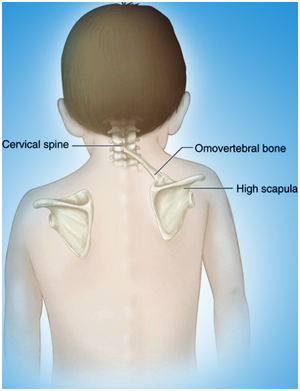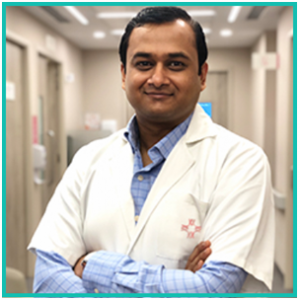Sprengel Shoulder Treatment in Gurgaon, Delhi
Seeking treatment for a child born with shoulder blades at varying levels i.e., on shoulder blade rests at a higher level than the other? If yes, then you need to approach Dr.Ratnav Ratan, a pediatric orthopaedic doctor in Gurgaon, Delhi.

Sprengel shoulder or Sprengel deformity is an extremely rare congenital skeletal abnormality. This condition is marked by an abnormally developed shoulder blade – scapula. The abnormally developed shoulder blade is positioned at an elevated level too.
Sprengel’sshoulder occurs during the early phase of fetus development when the shoulder blade has been unsuccessful in descending rightly from the neck to its actual position.
The left shoulder is the affected one in most cases, though it can occur in any of the shoulders or both shoulders. Sprengel deformity has been observed in girls mostly.
Anatomy of Sprengel Shoulder or Sprengel deformity
This deformity relates to the scapula which is also known as the shoulder blade. The scapula is triangular shaped flat bone with nearly 17 muscles attached to it.
Sprengel shoulder is marked by
Shoulder asymmetry – the affected scapula is located closer to the body’s midline and elevated in the range of 2 – 10 cms. The inferior pole rotates inwardly towards the spine and so the glenoid too turns inwards.
Hence, the affected side of the neck looks fuller and abnormal in shape.
Restricted movement of the shoulder abduction – raising of the arms sideways i.e. away from the body. The scapular mobility and abduction is further restricted by the presence of an omovertebral bone.
Also, the neck movement is restricted if the bone is located in the top section of the cervical spine. The presence of weak and abnormal muscles also limit the mobility of the shoulder joint.

In medical words, Sprengel Shoulder or Sprengel’s deformity is known as
- high scapula
- congenital high scapula
This condition is associated with related conditions such as congenital scoliosis, fused ribs, cervical scoliosis, spina bifida, Klippel–Feil syndrome, cervical scoliosis, and if an omovertebral bone present in the scapula area.

Dr. Ratnav Ratan, leading pediatric orthopedic doctor in Gurgaon, Delhi has treated children with cprengel shoulder conditions. Dr.Ratnav will check and perform a thorough medical examination of the child for the right diagnosis and suggesting a suitable treatment.
Diagnosis of Sprengel deformity
The orthopaedic surgeon will perform a thorough clinical evaluation of the patient along while observing the characteristic symptoms. The patient also undergoes special x-rays and advanced imaging tests such as Chest radiograph, i.e., anteroposterior chest x-ray, CT scans, and MRI.
The results of these imaging tests help in deciding the line of treatment, especially surgical procedures. Both these tests can detect the presence of an omovertebral bone and other tissue structures.
Classification of Sprengel shoulder based on the Cavendish grading system –
Grade 1 – Very Mild –
Shoulders are almost at level and the deformity is not noticeable if the patient is wearing clothes.
Grade 2 – Mild –
Shoulders seem to be at the same level with a visible lump of the higher shoulder blade.
Grade 3 – Moderate –
The deformity is visible and there is a vertical gap/distance of 2 – 5 cms between the affected and the unaffected shoulders.
Grade 4 – Severe –
The shoulder blade is very high and the mid angle of the shoulder blade resting at the back of the head with the webbing and shortness of the neck
It is not possible to classify the severity in bilateral cases of Sprengel shoulder.
Treatment of Sprengel Shoulder
The orthopaedic surgeon’s recommendation is the best path forward. This deformity is noticeable at birth and more visible by the child turns one year in age. Mild cases of Sprengel deformity go unnoticed till adolescence. Similarly, there will be a noticeable restriction in the range of motion of the shoulder blade and the shoulder joint.
Physical Therapy or Non-surgical Treatment
The orthopaedic surgeon and the physical therapist will suggest a protocol with exercises to maintain the range of motion in the shoulder and strengthen the weak shoulder muscles.
Surgical Approach
The main objectives of performing surgery are to improve
- The cosmetic appearance and contour of the neck
- The scapular function if it is severely impaired.
The orthopaedic surgeon will release the binding of the scapula and relocate the scapula. The omovertebral bone, if present and its related tissues will also be removed.
The ideal age for such a surgery is 3 – 8 years. Most surgeons suggest an early surgical procedure to resolve the condition i.e. before the child reaches eight years of age.
There have been cases with unsatisfactory outcomes wherein corrective surgery was performed on children aged beyond eight years.
If corrective surgery is performed on an adult patient, the nerves are likely to get damaged when removing the omovertebral bone and also when the muscle tissue is stretched while relocating the scapula.
Care after the Surgery
After the surgery, the operated arm is placed in a sling for three weeks followed by a gentle range of motion exercises – a combination of active and passive exercises and strengthening exercises. Physical therapy extends up to 6 months for best results.




